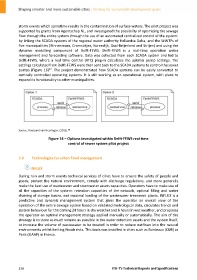Page 538 - Shaping smarter and more sustainable cities - Striving for sustainable development goals
P. 538
storm events which sometime results in the contamination of surface waters. The pilot project was
supported by grants from Agentschap NL, and investigated the possibility of optimizing the sewage
flow through the entire system through the use of an automated centralized control of the system:
by linking the SCADA systems of the regional water authority Hollandse Delta, and the WWTPs of
five municipalities (Binnenmaas, Cromstrijen, Korendijk, Oud‐Beijerland and Strijen) and using the
dynamic modelling component of Delft‐FEWS. Delft‐FEWS is a real‐time operation water
management and forecasting software. Data was collected from each SCADA system and fed to
Delft‐FEWS, where a real time control (RTC) plug‐in calculates the optimal pump settings. The
settings calculated from Delft‐FEWS were then sent back to the SCADA systems to control the sewer
37
pumps (Figure 16) . The project demonstrated how SCADA systems can be easily converted to
centrally controlled operating systems. It is still working as an operational system, with plans to
expand its functionality to other municipalities.
38
Source: Rooij and van Heeringen, (2012).
Figure 16 – Options investigated within Delft‐FEWS real‐time
control of sewer system pilot project
5.3 Technologies for urban flood management
INFLUX
During rain and storm events technical services of cities have to ensure the safety of people and
goods, protect the natural environment, comply with discharge regulations, and more generally
make the best use of wastewater and stormwater assets capacities. Operators have to make use of
all the capacities of the system: retention capacities of the network, optimal filling and water
draining of storage basins, and maximal loading of the wastewater treatment plants. INFLUX is a
predictive and dynamic management system that gives the operator an overall view of the
operation of the entire sewage system based on validated metrological data, calculates trends and
system behaviour for the coming 24 hours in dry weather and 6 hours in wet weather, and proposes
the operator an optimal management strategy applied manually or automatically. The aim of the
strategy is to store as much volume as possible in the water retention assets and the system itself,
to increase the volume of wastewater to be treated in order to reduce outflows into the natural
environments whilst limiting floods risks. This tools was installed in cities such as Bordeaux (CUB) or
Paris (SIAAP) in France.
528 ITU‐T's Technical Reports and Specifications

